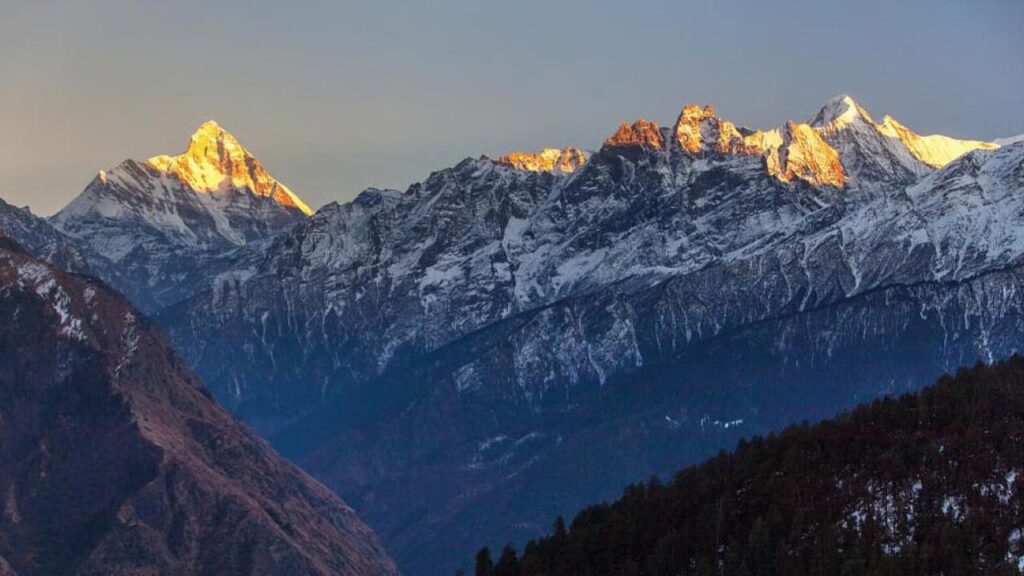Uttarakhand, a state nestled in the lap of the mighty Himalayas, is gearing up for a grand reopening of one of its most iconic peaks – Nanda Devi. After over four decades of inaccessibility, the mountain, standing tall at 7,816 meters (25,643 feet), is finally opening its doors to mountaineers and adventurers. This historic decision has been met with excitement, mixed with a bit of caution, as the environmental impact and cultural significance of the Nanda Devi region are paramount concerns.

Uttarakhand Reopens Nanda Devi for Expeditions After 40+ Years
| Key Detail | Description |
|---|---|
| Peak Name | Nanda Devi (7,816 meters/25,643 feet) |
| Years Closed | 42 years (since 1983) |
| Reason for Closure | Environmental concerns, Cold War-era nuclear surveillance operation |
| Reopening Date | July 2025 |
| Regulations for Expeditions | Strict permits, limited expeditions, and environmental safeguards |
| UNESCO World Heritage Site | Nanda Devi National Park |
| Impact on Tourism | Boost in adventure tourism with regulated access |
| Official Resources | Uttarakhand Tourism |
The reopening of Nanda Devi is a monumental event in the world of adventure tourism. For decades, this sacred and majestic peak remained off-limits, preserving its pristine beauty. Now, climbers and trekkers will have the rare opportunity to tackle one of the world’s most formidable mountains. However, the adventure comes with the responsibility to protect and preserve the unique ecosystem of the Nanda Devi National Park.
With proper preparation, respect for nature, and a strong commitment to safety, climbers can experience the grandeur of Nanda Devi while helping to ensure its protection for future generations. Whether you are a seasoned mountaineer or a passionate nature lover, this is an adventure of a lifetime – a historic journey awaits.
The Historic Reopening: What You Need to Know
The Nanda Devi Peak, named after the Hindu goddess Nanda, is not only the second highest mountain in India but also one of the most challenging peaks to climb. For over 40 years, access to this majestic summit was restricted due to environmental concerns and its strategic significance during the Cold War era.
In 1983, the Indian government imposed a ban on expeditions to Nanda Devi after it became a part of a sensitive nuclear surveillance operation. The peak’s pristine environment, which is home to some of the world’s most unique ecosystems, was under threat from human activity, prompting the need for the closure.
However, as the demand for adventure tourism in Uttarakhand surged, and following extensive discussions with the Indian Mountaineering Foundation (IMF) and the Uttarakhand Tourism Department, the Indian government has decided to lift the ban. The mountain is set to be reopened for expeditions in 2025.
Why Nanda Devi Matters
Nanda Devi holds a special place in the hearts of trekkers and mountaineers alike. Situated in the heart of the Himalayan range, it is surrounded by some of the most breathtaking landscapes, including the Valley of Flowers, a UNESCO World Heritage Site.
This peak is not just a mountaineer’s dream; it’s also a spiritual landmark for locals. Nanda Devi is revered as a goddess in the region, and it is believed that the mountain’s summit was so sacred that no one was allowed to climb it for centuries.
Its towering presence above the Nanda Devi National Park ensures that the region remains one of the most biodiverse areas in the world, housing endangered species like the Himalayan tahr and snow leopard.
The Environmental Considerations: Balancing Adventure with Preservation
While the excitement of reopening Nanda Devi is undeniable, there is a strong emphasis on preserving the environment that has remained relatively undisturbed for decades. The reopening of Nanda Devi is not a free-for-all; it comes with strict regulations.
- Limited Access: Only a small number of expeditions will be allowed each year. This is to prevent overcrowding and minimize the ecological footprint on the fragile mountain environment.
- Permits and Clearances: Climbers and trekkers must acquire permits from the Forest Department based in Joshimath. Foreign nationals will also need clearance from the Ministry of Home Affairs in Delhi.
- Guides and Local Support: Climbers will be required to have a local guide and support staff to navigate the mountain. The idea is not just to manage the environmental impact but also to support local communities that depend on tourism.
- Environmental Safety: Special attention will be given to waste management and avoiding disruptions to the local flora and fauna. Efforts will be made to ensure that climbers leave no trace of their presence on the mountain.
What Does This Mean for Adventure Tourism in Uttarakhand?
The reopening of Nanda Devi is expected to be a game-changer for adventure tourism in Uttarakhand. The state has long been a popular destination for trekkers and mountaineers, with peaks like Trishul, Nanda Ghunti, and Swargarohini already attracting thousands of tourists every year.
However, Nanda Devi stands apart due to its iconic status and the allure of untouched wilderness. The mountain’s reopening signals that Uttarakhand is ready to handle more sophisticated adventure tourism, with enhanced safety measures and better infrastructural support for climbers.
What to Expect on the Nanda Devi Expedition
If you’re planning an expedition to Nanda Devi, here’s what you should keep in mind:
- Preparation: The Nanda Devi climb is a technical expedition, meaning it’s not a walk in the park. You’ll need prior mountaineering experience and technical skills.
- Altitude: At 7,816 meters, Nanda Devi is not a summit for beginners. Proper acclimatization is essential to avoid altitude sickness.
- Season: Expeditions typically take place between April and October, with the best time being June to September when weather conditions are relatively favorable.
The journey will take you through some of the most remote areas of the Himalayas, and the trekking route to the base camp itself offers jaw-dropping views. As you ascend, you’ll encounter alpine meadows, thick forests, and, of course, the towering peaks of the Himalayas that form the backdrop of this legendary expedition.
FAQs
1. Why was Nanda Devi closed for so long?
Nanda Devi was closed due to environmental concerns and its involvement in a Cold War-era surveillance operation. The government wanted to protect its sensitive ecosystem from human interference.
2. What are the requirements for climbing Nanda Devi?
To climb Nanda Devi, you need prior mountaineering experience, permits from the Forest Department in Joshimath, and if you are a foreigner, additional clearance from the Ministry of Home Affairs.
3. How long will it take to climb Nanda Devi?
The climb to the summit can take anywhere between 3 to 4 weeks, depending on the weather, route conditions, and acclimatization.
4. What are the best months to visit Nanda Devi?
The best months to attempt a climb of Nanda Devi are from June to September when the weather is relatively stable, and the snow conditions are favorable.
5. Is Nanda Devi a dangerous peak to climb?
Yes, Nanda Devi is considered a challenging and dangerous peak due to its steep slopes, unpredictable weather, and high altitude. It’s only recommended for experienced mountaineers.








